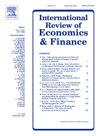Kill two birds with one stone: How to strengthen digital new infrastructure's impacts on urban green innovation – The channel of factor allocation
IF 4.8
2区 经济学
Q1 BUSINESS, FINANCE
引用次数: 0
Abstract
Fully releasing the growth-inducing effect of digital new infrastructure (DNI) on urban green innovation (UGI) not only facilitates the distribution of DNI but also enhances UGI, thereby achieving the effect of "killing two birds with one stone". However, this issue has received limited discussion. Given this, this study examines the impact of DNI on UGI, and explores how to strengthen DNI's impacts on UGI through the channel of factor allocation based on the panel data from 274 Chinese cities from 2008 to 2021. The results show that DNI significantly boosts the improvement of UGI. For every 1% increase in DNI, the level of UGI increases by 0.09%. Moreover, this effect is more pronounced in western cities, monocentric urban agglomerations, and the “from 1 to 100” application scenario stage. Factor allocation, consisting of capital factor allocation and labor factor allocation, is an important channel between DNI and UGI. Overall, DNI promotes UGI by mitigating capital and labor factor distortion. However, this effect varies across heterogeneous scenarios. The capital factor allocation channel demonstrates more significant mediating effects under the “from 1 to 100” application scenario stage, eastern cities and polycentric urban agglomerations, respectively; while the mediating effects of labor factor allocation channel are more significant under the “from 0 to 1” technological research stage, western cities and monocentric urban agglomerations, respectively. Our findings enrich the empirical evidence of the impact of DNI and provide new insights for promoting UGI.
求助全文
约1分钟内获得全文
求助全文
来源期刊
CiteScore
7.30
自引率
2.20%
发文量
253
期刊介绍:
The International Review of Economics & Finance (IREF) is a scholarly journal devoted to the publication of high quality theoretical and empirical articles in all areas of international economics, macroeconomics and financial economics. Contributions that facilitate the communications between the real and the financial sectors of the economy are of particular interest.

 求助内容:
求助内容: 应助结果提醒方式:
应助结果提醒方式:


